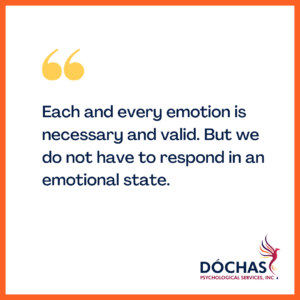It’s Paula on the Dóchas blog today, and I’d like to dive into the topic of emotional self-awareness.
In this fast-paced world where quick decisions are often demanded, taking the time to connect with our emotions might seem like a luxury we can’t afford. However, in this blog post, we’ll explore why developing emotional self awareness helps us navigate our experience in our world, and a few strategies to cultivate this essential skill.
What is emotional self awareness?
At its core, emotional self-awareness is the conscious acknowledgment of an emotion or feeling. Emotions, as human experiences, are not confined to our minds; they are also deeply intertwined with our bodies. Every emotion we feel serves a purpose, conveying valuable information about our lives. It’s important to recognize that all emotions are valid, and we don’t have to react impulsively to them.
There are several universal human emotions—such as happy, sad, mad, scared, disgusted and shocked. The way we experience and express these emotions varies greatly, and within each emotion there are degrees of, and other expressions of, each emotion. Scared, for example can have a higher intensity, such as terrified, or a lesser intensity, such as jittery, anxious, or frazzled. It takes work, practice and effort to name the feeling we are experiencing.
Strategies to practice emotional self awareness
The Emotion Wheel
To practice emotional self awareness, having a visual aid like an emotion wheel is a useful tool. An emotion wheel allows you to connect with and name your emotions. Instead of broadly categorizing a feeling as “anger,” you can identify it as frustration, violation, or confusion. You can break down each emotions into more specific emotions. And this is helpful because how we respond to one emotion may be a different approach than to another emotion!
To take the example of anger, the most helpful approach is to release the anger might be through movement, whereas if the emotion is “frustrated,” the better approach might be to talk it out or journal about it. Being able to name the emotion is integral to being able to respond to it. And regardless of the feeling, there is an approach to deal with the feeling!
Use your past emotional experiences to recognize your emotions and strategize your response to them
Emotions do pass, and the intensity of feeling emotions does lessen. Think about a time you felt frustrated with something or someone. If you can identify the feeling you felt at that time, you become aware when that emotion is surfacing again. That self awareness can navigate how you proceed, now that you recognize you are feeling frustrated. Will you continue with that activity or conversation that is bringing up frustration, or will you choose to respond differently (such as taking a break to let the emotion pass)?
Recognizing the role of your style of thinking on your emotions
Style of thinking can shine light into a feeling. Feelings are prompted by the emotional processing amygdala in the brain. When the amygdala is activated, the ability to think rationally and logically is impaired. This influences how we think about things. If we’re feeling happy, our thoughts may be optimistic and pleasant, with positive associations. But the thoughts associated with feeling excitement, or shock, or surprise differ from the happy thoughts. Observing or noticing the style of thinking can shed light to how our brain may be firing.
When we recognize how our brain is currently firing, we be careful how we proceed in times of emotional thinking overload. You are not thinking “clearly” with the prefrontal cortex deactivated when you are angry, or frustrated. The thinking style in that felt emotion can lead to thoughts of criticism, judgement or self deprecation, among others.
Notice how you think about something. Is it logical and rational, or is there an emotional thought activation? A personal cue, when I notice that I think of a situation with personal criticism or impose judgement, that is not the rational, diplomatic self that I strive to be. It helps to acknowledge that my thinking style is dictated by a feeling. I would much rather name the emotion, deal with the emotion and return to thinking about the situation when I can think clearly.
Cultivating Emotional Self-Awareness
In a society that often values quick, impulsive decisions, developing emotional self-awareness requires conscious effort and practice. Slowing down and giving yourself time to identify your emotions, understand your thinking style, address your feelings, and allow your prefrontal cortex (responsible for executive functions like decision-making) to come online is crucial.
Practicing emotional self-awareness means giving yourself the processing time necessary to make well-informed decisions and respond thoughtfully to the web of emotions that make up our human experience. If you’d like a helping hand with navigating this, reach out to us here at Dóchas! You can reach us at 780 446 0300 or drop us a line at info@dochaspsych.com.
About Dóchas Psychological
Dóchas Psychological Services is a well-established and trusted therapy clinic located in Spruce Grove, Alberta. At Dóchas we value the idea that everyone deserves a safe space. Through connection and education, our team works hard to build a trustworthy relationship with each of our clients. It is our goal to create a community for our clients to feel like they belong.
Disclaimer
Information provided through Dóchas Psychological Services blogs or vlogs is meant for educational purposes only. They are NOT medical or mental health advice. You can read more about our disclaimer here.











